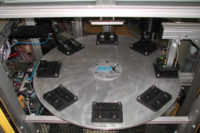Strain Gauge Enables Bipedal Robot to Walk




Technical universities are often taken for granted in their development of manufacturing technology. Thankfully, this is not the case in Germany.
In Munich, the Fraunhofer network of 72 technical institutes serves as an example of how researchers and manufacturers can successfully work closely together to advance industry. Not far away, in Darmstadt, sits another technical university filled with many types of researchers, including those that specialize in robotics.
In 2017, researchers in the Simulation, System Optimization and Robotics Department undertook a unique and challenging project: Develop a prototype sensorial foot for load-bearing walking robots using cost-effective strain gauges rather than more expensive and advanced sensors.
Step one in the process was obtaining economical strain gauges that offer high accuracy and performance. The Darmstadt team looked first to HBM (now an HBK company) based on its reputation, proximity and previous university research projects involving strain gauges.
A total of 12 gauges were obtained from HBM. Four are model K-TA11K3/350 strain gauge rosettes. The other eight are model K-LU13K1.6/350 standard gauges. All of them are coated with phenolic resin-based P250 adhesive to quicken installation and minimize output signal scattering.
Next, the team carefully positioned the gauges in three full-bridge (square) configurations on an aluminum cylinder that serves as the robot foot. One bridge is inside the cylinder and two are on the outside. Several side holes allow gauge wiring to easily pass in and out of the cylinder.
The researchers chose the full bridge configuration, rather than a quarter or half-bridge one, primarily because it measures even the smallest resistance changes. They also like that it is linear, and gauge output is directly proportional to an applied force, with no approximation.
On the bridge positioned within the cylinder, four K-TA11K3/350 strain gauge rosettes measure the Z force. A rosette refers to two tiny gauges positioned next to each other to measure strains along different directions. In this case, one rosette is located on each side of the square. For each of the two outer bridges, four K-LU13K1.6/350 gauges measure the X and Y forces separately.
After installing the gauges, the team set up its ANSYS Workbench 19.1 software to display any bridge deflection and qualitative gauge strain (in each force direction) during testing. Gauge calibration was then performed, with a focus on measuring range (±0.156 volt) and input signal (11.42 to -28.90 millivolts, depending on force direction).
Finally, the team completed the prototype’s initial test run with impressive results. For the X force, the gauges showed an average relative error of only 1.5 percent with a mean absolute deviation of 3.
The Y force results showed an average relative error of 2.6 percent with a mean absolute deviation of 4, and the Z force results were 3.1 percent for a deviation of 23. A follow-up project is being conducted at the university to further optimize these results.
One of HBM’s newest strain gauge series is the KFU, which is designed for structural tests in high-temperature conditions up to 350 C. The gauges come with a 1-meter-long wire, and are available with a 2- or 5-millimeter grid, depending on the application requirements.
For more information on strain gauges, call 800-578-4260 or visit www.hbm.com/en.
Looking for a reprint of this article?
From high-res PDFs to custom plaques, order your copy today!








